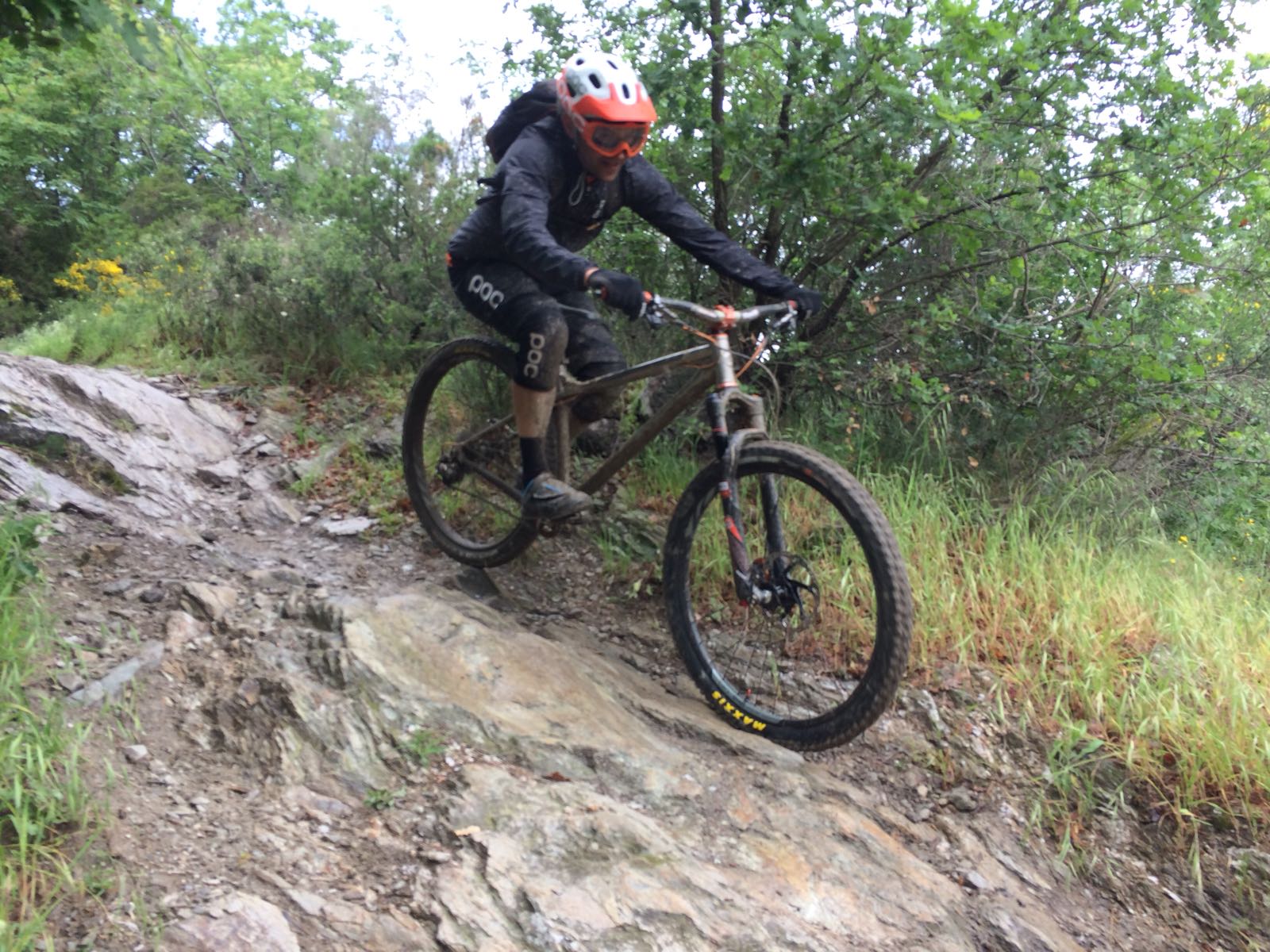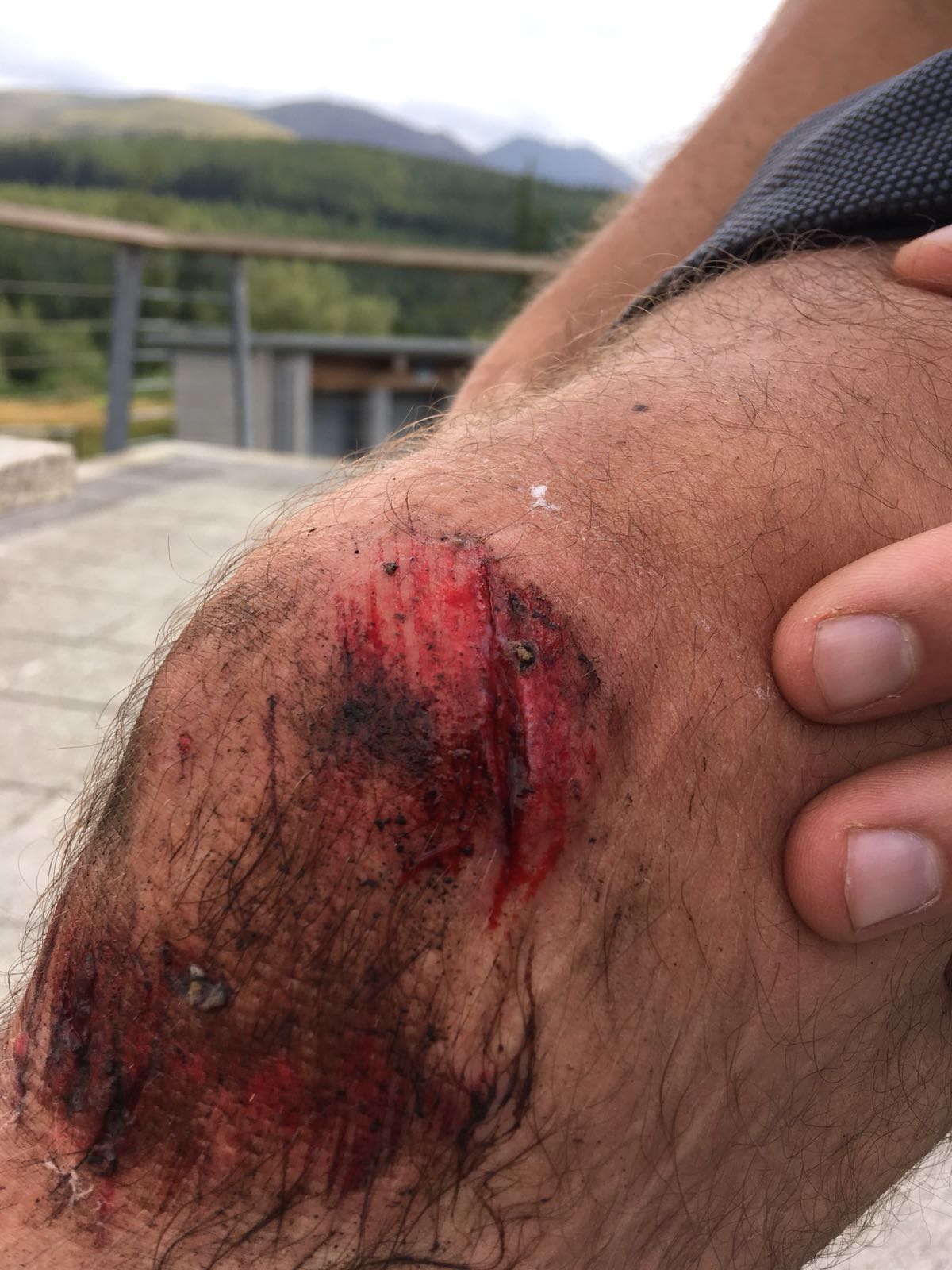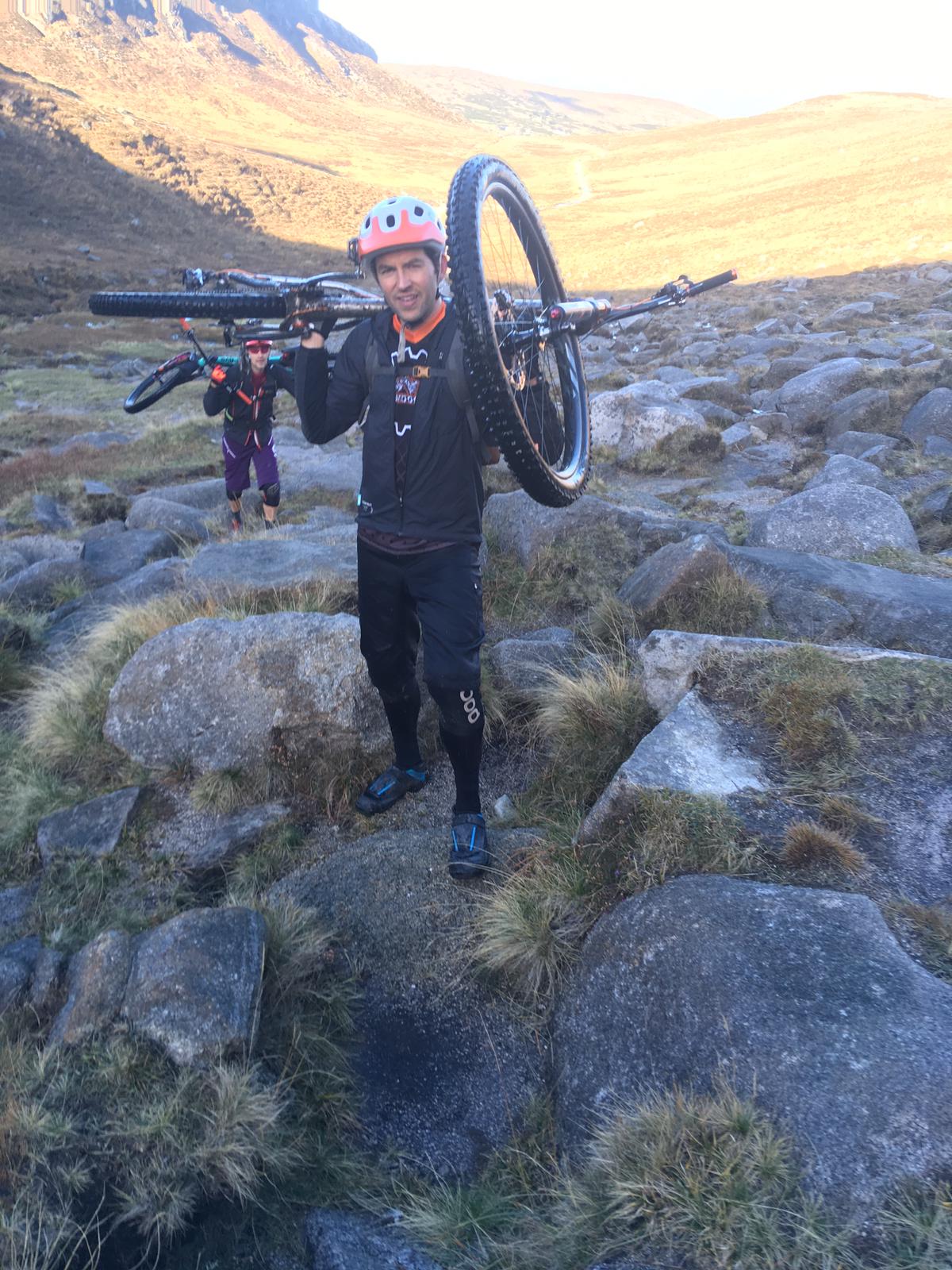But Why?….
Why the hell do I ride a hardtail?
It’s not like it’s a puritantical stance against technological advance. If that were the case then I’d also still be on a 150mm stem, 540mm bars, 26″ wheels and those god awful tan wall tyres. Oh, wait, those have made a comeback?! Maybe the Flexstem and that batshit Slingshot bike with the wire for a down tube will be next, after all, fashion is cyclical.
But bikes aren’t fashion (not for most of us anyway), they’re engineering, and sometime in the last three decades full-suspension frames have honed to an unbelievable degree of capability, swallowing the most techy of nastiness with ease, and surely rendering other approaches obsolete?
I’ve had numerous springy rear-ends, the cream of the crop too from the likes of GT, Commencal, Rotwild, Santa Cruz and Ibis, but after over thirty years of riding have reverted back.
So again, why a hardtail?
It’s not a decision driven by financial imperatives either. I’m a bit embarrassed to admit that the Switch9er in its current guise would cost upwards of £6k to replace, more expensive than all but the most extravagant of bouncers. In my defence, I have no other vices left, and it is technically a work tool but nevertheless it’s essentially unjustifiable.
But this isn’t about NEED, it’s about WANT.
But why WANT a hardtail?
Okay, here goes;
- They require a precision in riding style that appeals greatly to me. It’s not about ploughing through and hanging on, it’s threading needles and reading terrain in a way that favours experience and ability over balls and bloody-mindedness.
- Which gives me a ready-made excuse to be a cop-out. I’ve done my time to be fair, a list of broken bones, torn muscles and concussions that’d have made Evel Knievel wince, but at my current age I’m just getting a bit wimpy when it comes to the big stuff. As a professional bike coach, there’s an expectation that I’ll do all the gaps and drops but being on a hardtail suddenly removes that pressure, nobody expects much of you when you’ve no travel out back.
- Which leads on to the immense satisfaction of battering past people on their 160mm travel machines. Be it Enduro results sheets, Strava times in foreign climes or out on the local trails, there’s an inherent smugness to easing away from people who thought they’d be passing you half way down a trail.
- They’re easy to clean and maintain. Funnily enough I haven’t blown a rear shock in years!
- They’re aesthetically beautiful, and when done right are definitely art. What’s more, it’s great to know that your dream bike won’t be immediately superseded by a new design next year.
And that all leads back to the glorious Stanton Switch9er Ti, the current culmination of three decades of my MTB obsession, and in all probability my favourite bike of all time.

Tearing up some damp Italian rockiness.
Why so Good?
The first impressions article, penned back in April 2018 had these early observations;
- It’s the best hardtail I’ve ever ridden. And we’re talking a different league entirely. Uphill, downhill, in corners, floating over the tech, everywhere. I’m going to be looking extremely hard but as yet there haven’t been any hints at anywhere that it doesn’t genuinely excel.
- Forget all you know/have heard about 29’ers lacking feel. If I could somehow blindfold you and keep you unaware of the size of the hoops until you were piloting this bike, you’d only notice that you were travelling faster than ever before. It wants to be hopped, chucked, thrown, abused, attacked. All the benefits, none of the downsides, and I’d be the first to admit that as much as I love 29’ers, they do generally sacrifice playfulness for outright speed.
- The dimensions are as close to perfect for our tight, techy trails as anything I’ve ridden. Long enough to be stable in high-speed chop but able to nip between the trees and rapidly change direction as so often required here. It loves being pointed down rocky chutes and off-camber roots but also laps up the fire-road ascents.
- It addresses the ‘weaknesses’ I found in the Sherpa (my previous ride). I took liberties with my last Stanton, setting it up in a manner unbefitting to a supposed ‘trail’ bike. The 140mm forks (as opposed to the recommended 100-120mm) artificially raised the bottom bracket, resulting in a slightly top-heavy feeling when rapidly switching between corners, an inability to achieve that wonderful sensation of carving, when your centre of gravity drops right into a bend. This bike is designed around my preferred fork length and so all has fallen into place.
- It’s silent. And that’s really important to me. If those internal cables and hoses had rattled then that would be a deal breaker for me but there’s no noise at all, particularly with my favoured inner tube wrap on the chainstay. The threaded bottom bracket shell will also prove vital in this regard.
- It looks incredible. And I’ve never quite previously warmed to the aesthetics of bikes that sometimes appear to be ‘all-wheels’. Does this impact on the ride? Well to me, yes it does, that overall feel good factor that draws my eyes repeatedly back to it whenever we’ve stopped is a vital part of the whole experience. I’ve owned ugly bikes, and somehow it just prevents that wonderful symbiosis developing between the living and the inanimate.
And Since Then?
Obviously those initial rides had me waxing lyrical, but the early throes of a love affair can turn sour over time. Foibles that originally endear can start to grind. Did I fall further in love or has the ‘9er been cast aside for another suitor?
Simple answer, I no longer own any other mountain bikes. What’s more, I’ve no intention of even looking for one, and as an early adopter with a straying eye for the shiny, that’s a huge statement.
Original impressions have been enhanced massively. From the bone-dry bedrock of Finale Ligure to boggy hike-a-bike in the Mournes, the ‘9er has totally blown me away. It’s extremely stable, both on the ground and also the rare occasions I rise above, the low bottom bracket (for a big wheeled machine) creating a stable platform for carving corners and straight line smashing. Initially the notable fun increase emanated from geometry and sizing, a 65.5 degree head angle and low slung top tube providing confidence on the steeps and turns where 29ers always demonstrate more poise. Latterly, I’ve realised the incredible attributes of the top grade 3AL2.5V titanium tubing, it’s immensely forgiving, deflecting rock gardens and soaking landings effortlessly. Much fuss is made over the suitability of titanium for two-wheeled fun and it’d be easy to call it hype, retaining that mythical status to justify eye-watering price tags. I’m no lover of bullshit hyperbole but am compelled to perpetuate that impression; there truly is no ride feel like it.
Point It Up…
And it climbs well, very well. If we’re totally honest here, the goalposts have moved a bit in this regard over the last fifteen years. Compared to the XC hardtails I raced as a teenager, the slack front end and short stem/wide bar combo don’t make for the most rapid progress, even with the retention of a relatively upright 74.5 degree seat tube angle. However, this bike utterly takes the piss out of other bikes I’ve owned which supposedly ‘climbed like a goat on steroids’ (blah, blah, media bullshit). Granted, I’m a bit fitter than your average rider, so don’t often get caught when the gradient rises, but I genuinely don’t recall being passed by anyone on a climb the whole time I’ve ridden this beast. I’d be intrigued to ditch the 2.4″ tyres for something racier and see if it could compete in a Cross Country race. Most tellingly, it is an improvement over the Sherpa that preceded it, supposedly a more ‘trail’ oriented bike, maybe due to the lightness of the tubing?
Then Point it Down…
Release the brakes and grin, then laugh and whoop involuntarily…
There are longer, slacker frames than this that should theoretically outperform the ‘9er on the descents, but I’ve ridden bikes with that supposedly amazing ‘long front-centre’ and they handled like a barge. If there’s one criticism of 29ers that I’d readily accept it’s the fact that they can lack playfulness, sacrificing ‘pop’ for speed. Through design and material excellence, the Switch9er Ti retains a chuckable feel that enhances the best of the wagon wheels and nullifies the downsides. Truly the best of both worlds. I’ve not raced it much, last season being dictated by international running commitments, but when I did, it dominated completely.
A week of smashing Finale Ligure’s finest trails cemented the love, soaking up repeat drops without any hint of bodily fatigue. When hardtails can be this forgiving, it’s entirely valid to question the need for suspension.

Not quite ALL happy memories on the ‘9er, and yes I was wearing knee pads! It was a loooong slide on the flint after a dodgy gap jump landing.
Versatility is Key
I do mostly subscribe to the ‘enduro’ approach to riding, spinning (or beasting) the climbs before focusing on maximum downward velocity. However, the ready access to the open mountains here in the Mournes does occasionally invite an epic hike-a-bike mission over bog, granite and wind-swept mountainside. The ‘9er is light, despite a bulletproof build and heavy-duty rubber, and so slinging it on to my back for a thirty minute calf burning trek is little hindrance to enjoyment, and saves energy for the 800m of vert back to sea level. The simplicity of a classic ‘double-diamond’ frame also means no pivots or kooky shock placements digging into the back of my neck. I’ve done multi-hour epics, top speed interval sessions, DH smashing and even some lengthy road sections and never once felt under or over biked. As previously mentioned, this is my ONLY mountain bike, and I used to have four on the go! There’s an incredible satisfaction to having a bike that does everything well, it’s no jack-of-all-trades, it’s a master of most.

Hike-a-bike fun in the real mountains.
Box Fresh Beauty
Early Winter saw the ‘9er taking an unfair degree of beating, being slogged through the grime repeatedly with only a handful of days respite in a couple of months. Every day it was battered, hosed, dried and then chucked in the van for the next day’s action. My job is awesome but it can be brutal on equipment, and the simple fact remains that in order to make a living I need a bike that functions constantly whilst also appearing professionally spotless. I don’t think any non-hardtails would’ve survived that period, as much for the endless power-washing as the bearing eating gloop. I know you shouldn’t hose directly and up-close but there’s only a short cleaning window as a winter-time bike coach before frozen digits start falling off and darkness renders it impossible.
Last week I finally applied the strip-down treatment it deserved. The dropper cable was a bit chalky and the oil in the fork lowers was decidedly brown, but following a proper clean up it’s basically back to new, in fact the frame is all but showroom quality. None of the lacquer dulling top tube scrapes from encrusted baggies, no unsightly chipping from numerous stone strikes, and amazingly for me, not even a sign of the continual left heel rub on the chainstay. The scratches polished out with fine wire wool and virtually the only sign of use at all is where cable rub has polished the ti a bit on the head tube. I’m aware that many people don’t give a shit in this regard, cherishing minor damage as a badge of honour, low-level abuse catalogued tangibly, but I like my kit to stay new and so am delighted with the boxfresh appearance. Components will come and go, but the heart of this machine will stay beautiful long-term.

Sum total of the damage from a year’s thrashing!
Don’t Forget the Details
To keep up-to-date in an industry where ‘standards’ seemingly change on an hourly basis is tough, Boost being the latest needless abomination. Stanton have sidestepped this problem with the awesome swopout dropouts that allow the same frame to run 135QR, 142, 148, horizontal singlespeed and no doubt whatever the next whim of the Trek/Specialized/SRAM marketers wet dreams may be. No fiddly, tiny bolts holding them in either, waiting to be rounded out or lost on the trail, these dropouts use chainring bolts, letting a proper torque be applied. The head tube is 44mm straight, allowing for changes in fork steerer configurations. The stunning chainstay yoke has room for 27x 2.8″ tyres as well as 29x 2.4″. The bottom bracket shell is threaded and ISCG mounts should cater for any chain guide requirements. It’s as future-proof as can possibly be expected.
The welds, my god, the welds, they’re Picasso, Michaelangelo and Banksy in one; pure art. Visual signatures of craftsmen at the peak of metallurgical excellence. In my mind, the welds are everything, a representation of the values of a company beyond the slick edits and aspirational photos. Some companies seem not to care, glossing over their deficiencies in manufacturing standards with excessive propaganda. You want to know about a bike company’s ethos, take a magnifying glass to the details and I guarantee that’ll be reflected in the quality of their after-sales. There aren’t many manufacturers where you can quite often ask direct questions to the designers and company owner and get immediate answers on Facebook. Stanton deserve huge respect for their approach and have a very dedicated following as a result.
Downsides
Are few, far-between and entirely personal. I’ve noticed myself adding more and more spacers beneath the stem, unable to shake a feeling of the front end just riding a bit low in the steeps. Riding hardtails well necessitates an aggressive, front-heavy style that naturally dives the forks when drops get steeper and front brakes are applied. As a result I ramp up the MRP cartridge in the Pikes and keep them as high in the travel as possible, whilst maintaining acceptable small-bump sensitivity. Even with this tweaked set-up, I do still wish the front end was half an inch higher. I’ll cure this issue with new bars soon.
Beyond that, errrr, the internally routed brake hose can be a pain in the arse, but I think entirely worth the effort and the occasional new olive whenever I need to remove the brake entirely (which is very rare) when the stunningly clean lines are the result.
And that truly is that, from a tester who is beyond obsessional and ultra-demanding. I’ve owned many, many bikes over the years, and never before had one that I could draw so few complaints about.
Conclusions
I’ve always retained a hardtail for one reason or another, sometimes nostalgia for twenty year old race bikes, sometimes as a refreshing alternative (like my incredible Ibis Tranny singlespeed), but until a couple of years back they were always a sideshow, brought out for the occasional novelty spin before returning to the bouncer. I value many things in bikes, handling, light-weight, reliability, aesthetics (and particularly manufacturing excellence) and that often intangible glow that comes from their ‘feeling’ on the trail. In the days before suspension took its inevitable grip, the likes of Merlin, Litespeed, Dekerf and others turned out masterpieces that were every bit as beautiful and cripplingly expensive as today’s superbikes, but handling-wise they’d be virtually unrideable on today’s beefed-up trails (we ride things steep and natural here). In the last few years a notable hardtail resurgence has swept the forests and mountains, machines retaining the advantages of simplicity and light-weight but through geometrical advances, narrowing the capability gap once more. Stanton have sat right at the forefront of this movement from day one, and with the Switch 9er Ti they’ve created a bike that truly excels in virtually all areas. To talk about value for money on an £1850 frame without shock or pivots may seem obscene, but this thing will be riding over the piles of long obsolete frame designs, seized bearings and blown-out seals for years to come. What’s more, if I decide to move on in future (because eventually we’ll all be on e-bikes), a quick polish and it’ll be good as new again for a re-sale or a couple of hooks above the mantelpiece. Art for art’s sake is all well and good but functional art is something else entirely. Sell a kidney, you’ll not regret it.
Any questions about any aspect of my bike, drop me a line or if you fancy a spin then I’ll be at the Vitus First Tracks Enduro series throughout 2019 as well as various mountain ranges throughout Europe.
The Stanton Switch9er costs £1850 (frame only) and is available direct from Stanton Bikes.

